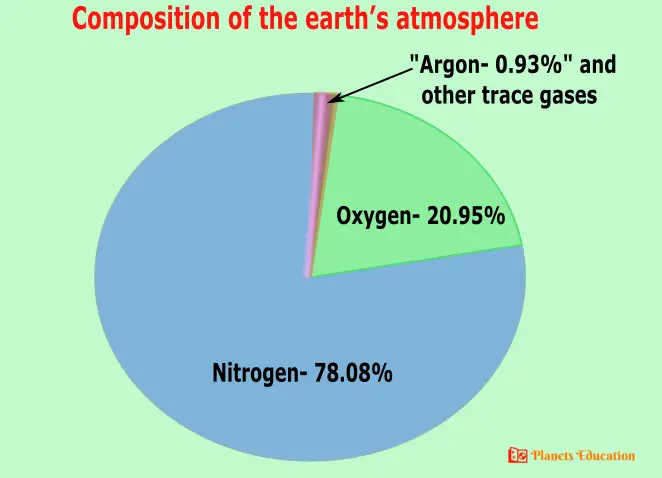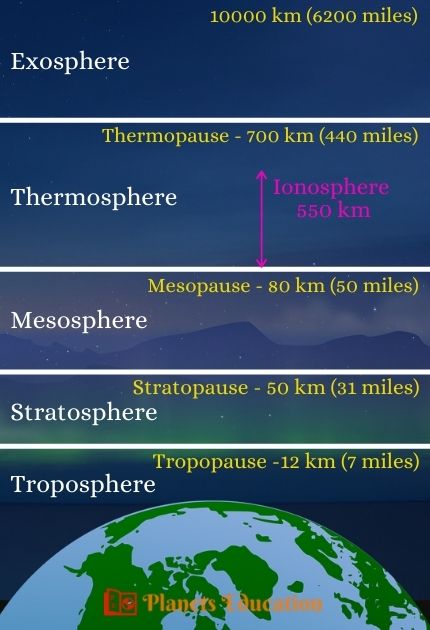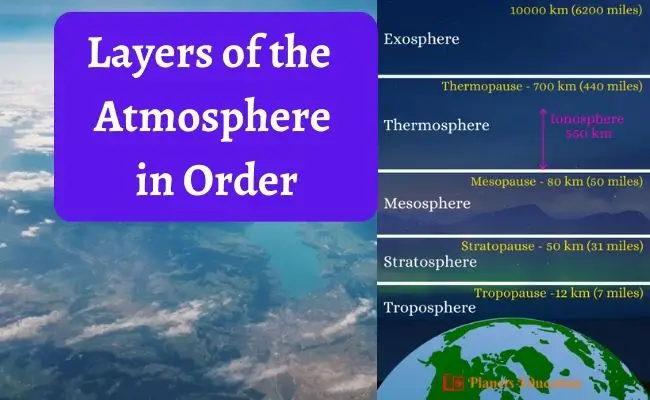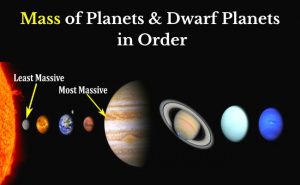An atmosphere is the gases covering the planet that are held on by its gravity. These surrounding gases can be divided into a set of layers. Our planet earth has 5 layers of the atmosphere. So, the earth’s five layers of the atmosphere in order are Troposphere, Stratosphere, Mesosphere, Thermosphere, and Exosphere.
| The Earth’s five layers are organized like an onion’s skin. |
“Here in this article, you will know about atmosphere layers in order, earth’s atmospheric gases composition, atmospheric pauses, how it helps to sustain life on earth, many other information with proper diagram (images).”
5 Layers of the Atmosphere
The atmospheric layers start from the ground level of the earth and rise up to a certain height according to its temperature, pressure, composition, and other properties. From the ground level, they are:
- Troposphere:- (0 -12 km) or (0 to 7 miles)
- Stratosphere:- (12 -50 km) or (7 to 31 miles)
- Mesosphere:- (50 -80 km) or (31 to 50 miles)
- Thermosphere:- (80 -700 km) or (50 to 440 miles)
- Exosphere:- (700 -10000 km) or (440 to 6200 miles)
Between the layers of the atmosphere, there are zones called ‘pause’. 5 layers of the atmosphere have 4 pauses, named as:
- Tropopause
- Stratopause
- Mesopause
- Thermopause
We know the simple meaning of ‘pause’ is ‘stop’. For example, tropopause means the end of the troposphere layer, the same as stratopause means the end of the stratosphere.
Though the earth’s atmosphere layers are made of gases. Therefore before knowing the layers of the atmosphere in order, here we will see the composition of the gases in the atmosphere.
Earth’s atmosphere composition
The atmosphere of the earth has been made of many gases and these gases are usually called ‘air’. How much amount of these gases are available in the earth’s atmosphere, is called the composition of the earth’s atmosphere.
Earth’s atmosphere composition or percentage of gases in the atmosphere by volume is given below:
- Nitrogen- 78.08%
- Oxygen- 20.95%
- Argon- 0.93%
- Carbon dioxide- 0.041%
- Water vapor- 0.0028%
- Neon- 0.0018%
- Other trace amounts of gases- such as Helium (He), Hydrogen (H2), Methane (CH4), Krypton (Kr), Ozone (O3), Xenon (Xe), and greenhouse gases.

These gases have some specific regions in the whole atmosphere. Ozone gas (O3) is found at a height of around 15 to 35 km in the stratosphere layer. Whereas Earth’s oxygen level or oxygen percentage in the atmosphere is around 20.95% by volume and is mostly found in the troposphere layer.
- Must Check:- Best Air Purifiers in 2023 by Airy Purifier.
Layers of the Atmosphere in Order
Here we have mentioned Earth’s 5 layers of the atmosphere in order with the proper diagram (image). We have also given detail about the 4 pauses in the atmosphere.

1. Troposphere
The troposphere is the first and lowest layer of the atmosphere of the earth. It extends from the surface of the earth to an average height of 12 km. The troposphere contains more than 80% mass of the earth’s atmosphere.
Must Check:- Interesting facts about the Earth
We can say, this is our layer because we live at the bottom of this layer which is called the surface of the earth. This is the layer where we can experience the weather and seasons of the earth. So this layer is also called the ‘weather layer’.
Water vapor, clouds, moisture, and other weather-associated winds all are found within this layer. At a height of 5 km from the earth’s surface, it contains a 50% mass of atmospheric gases. The temperature of this layer decreases with height and it ranges from (25ºC to -60°C) from the surface to the tropopause zone.
The troposphere layer can be accessed by propeller-driven aircraft.
Tropopause
The tropopause is the transition zone of the troposphere and stratosphere layer. It locates at the top of the troposphere layer and the bottom of the stratosphere layer. At this zone/height, the temperature stops decreasing. (‘tropo’ means ‘change’, and ‘pause’ means ‘stop’).
2. Stratosphere
The stratosphere is the second layer of the atmosphere from the earth’s surface. It lies above the troposphere and below the mesosphere. The stratosphere extends from 12 km to 50 km of the earth’s surface.
In this layer, the temperature rises with increasing height and it ranges from (-60ºC to 4ºC) from the tropopause to the stratopause zone. Ozone(O3) is present in this layer. The ozone layer absorbs the ultraviolet radiation of the sun and increases the temperature of this layer.
This layer is free from clouds and other weather-associated air turbulence. Because of this, it provides the best condition for the flying of jets and large airplanes.
Jet-powered aircraft could reach the level of the stratosphere layer.
Stratopause
At about 50 km from the earth’s surface temperature start falling again and is the pause zone of the stratosphere called stratopause. The stratopause is a transition zone and locates between the top of the stratosphere and the bottom of the mesosphere layer.
3. Mesosphere
It is the 3rd layer of the atmosphere from the earth’s surface and contains the region above the stratosphere and below the thermosphere. The mesosphere extends an altitude of 50 km to 80 km from the surface of the earth.
The temperature of this middle layer of the atmosphere decreases with altitude and ranges from (4ºC to -90ºC) from the stratopause to the mesopause zone. The mesosphere is the coldest layer of the atmosphere with an average temperature of -80ºC.
This layer helps us by burning up most of the meteors. The mesosphere layer can be accessed by rocket-powered aircraft.
Just below the mesopause, the mesosphere layer contains noctilucent clouds (night-shining clouds). These noctilucent clouds are the highest clouds of the atmosphere and it is made up of ice crystals.
Mesopause
At about 80 km from the earth’s surface temperature starts rising again and this is the end of the mesosphere called mesopause. It locates between the mesosphere layer and the thermosphere layer.
4. Thermosphere
The thermosphere is the 4th layer of the atmosphere from the earth’s surface and is the 2nd highest layer. The thermosphere lies between the mesosphere and the exosphere layer. It extends from a height of 80 km to 700 km in the atmosphere of the earth.
The gases of this layer absorb X-rays and ultraviolet radiation of the sun. Because of this absorption of radiation, it raises the temperature of the layer at around 1500 degrees Celcius. Hence in the thermosphere layer temperature ranges from (-90ºC to 1500ºC) from mesopause to thermopause.
The thermosphere layer protects us from meteors and obsolete satellites by burning up with its high temperature. So this layer burns up the space debris coming towards earth.
Sometimes aurora lights can be seen in the thermosphere layer.
Ionosphere:-
The high temperature of this layer breaks the molecules of the gases into positive and negatively charged particles or ions. So the thermosphere layer is also called the ionosphere. Mainly ionosphere extends at about 80 km to 550 km above the earth’s surface. These ions of the ionosphere reflect the radio wave toward space which results in high-range radio communications.
International space station (ISS) orbits at a lower height of 300 km to 400 km from the earth’s surface so this is the layer where ISS located.
Near around 60 kilometers from the earth’s surface, the location of the magnetosphere starts. Mostly from the thermosphere region and it extends up to 30000 – 60000 km, depending upon many factors.
The magnetosphere of the earth and the 5 layers of the atmosphere of the earth both are different terms but somehow help the earth. Know here more about the magnetosphere of the earth.
Thermopause
The transition zone between the end of the thermosphere and the start of the exosphere is thermopause.
5. Exosphere
It is the highest layer of the atmosphere and lies above the thermopause. It is located at an altitude of 700 km to 10000 km from the earth’s surface.
This layer has low-density gases like hydrogen, helium, oxygen, nitrogen, and carbon dioxide. Atoms and molecules of these gases are free-moving particles and usually do not collides with each other. These particles can travel hundreds of kilometers without a single collision.
The exosphere layer contains many of the satellites that are orbiting around the earth.
How Atmospheric Layers are Helpful for Life on Earth?
Each and every 5 layers of the atmosphere has its own benefits. The atmospheric layers help to sustain life on earth, from a life of a little insect to big living creatures including humans.
Here below you can find how these layers in order are helpful:-
- Troposphere – Within this layer humans and other lives live on the surface of the earth. Here we can see the weather and seasons.
Check about:- Why and How do Seasons Change on Earth?
- Stratosphere – This layer provides the best condition for the flying of jets and large airplanes.
- Mesosphere – This layer helps us by burning up most of the meteors in the sky. Here a rocket-powered aircraft can fly easily.
- Thermosphere – This layer helps us by burning space debris coming towards earth including obsolete satellites, meteors, and small-size asteroids.
- Exosphere – It helps us by providing the best condition to held satellites where it orbits around the earth.
So these were the 5 layers of the atmosphere and how these layers are different from each other. All these five layers of the atmosphere help to sustain life on the earth including with magnetosphere.
We, humans, need to care about these atmospheric layers and in return, it will care about us. Hope you have liked this article about the atmosphere of the earth and its five layers in order. Do comment on your point of view.
- Related: Magnetosphere of the Earth: All Informative facts
- Read also: Plant Cutting
- 5 Best Solar System Backpacks in 2024
- Mass of Planets in Order from Lightest to Heaviest
- Star Projector {2024}: Star Night Light Projector





Very informative content. Thanks for sharing.
Glad you like it…
Appreciate this post about a short description of the atmosphere of the earth.
Like!! I blog frequently and I really thank you for your content. The article has truly peaked my interest.
I am really grateful to the owner of this website who has shared this impressive piece of writing at
at this place.
Glad you like our post “5 layers of the atmosphere”.
Howdy! Would you mind if I share your blog with my myspace group?
There’s a lot of people that I think would really appreciate your content.
Please let me know. Many thanks
Yes, Anyone can share my posts with the proper mentioned our name and links.
Thanks.
Comments are closed.